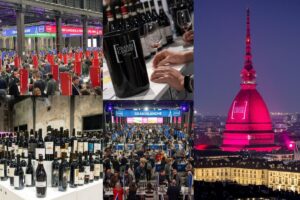With a production value of 143 billion euros, of which almost 12 billion are linked to the wine segment, the wine & food sector in Italy, with its 35.5 billion shipments, is worth 8.3% of the country’s total exports. This is the macro data emerging from the research “The wine & food sectors and the challenge of recovery” by Pambianco, together with Pwc, a giant in management and strategic consulting services, auditing and legal and tax consultancy, presented yesterday in Milan, in the setting of the Palazzo della Borsa, at the Wine & Food Summit no. 1, signed by Pambianco, which focused on “The wine & food sectors and the challenge of recovery - The responses of companies, catering and retail in the new competitive context”.
The research then focused on the wine segment, showing that Italy is the world’s leading producer with 19% of the hectolitres of wine produced, followed by France (18%) and Spain (16%). Italy is also on the top step of the podium in terms of hectolitres exported, but in second place in terms of value, behind France, which still has an average selling price per liter almost double that of Italy, and four times that of Spain. To date, the USA, Germany and the UK are our leading foreign markets, and together they account for 52% of Italian wine exports. Although China and Russia are respectively the sixth and seventh largest countries in the world in terms of wine consumption, the Italian brands are still not very present in these markets and therefore represent a great opportunity for development. Lastly, there is evidence of distribution channels and their changes in 2020, with the strong growth of online sales which, while still worth 3%, has grown by 171%.
pandemic has permanently changed consumption habits, with new trends for the wine & food industries that can become a development opportunity, if seized in a timely and profound way. For 49% of respondents, the growth of e-commerce in the wine sector will continue beyond the emergency, while the decline of the Horeca channel will be permanent for 25% of the panel. Companies are fighting back by innovating services and products, for example through the development of wine tourism, which will be a key element for 48% of respondents. Around half of consumers say they are more eco-friendly than in the past and 53% choose the healthier option when buying food. A preference for “local” products and companies and a greater focus on price, probably due to the impact of the pandemic on individual incomes, complete the picture painted by the research.
Sergio Scornavacca, Director Industrial Market of Minsait, presented the research “Wine and its Human Customer Intimacy”, from which it emerged that the “next normal” we are experiencing has reaffirmed how important it is to build a human, almost intimate and personalized relationship between consumers and companies, both in terms of service and product. This is a paradigm that is touching all sectors, obviously including the wine sector, regardless of size: from the home shop to the medium-sized and large company.
An analysis conducted by Minsait and BlogMeter regarding social networks and blogs on trends and “hot topics” showed that in the last year alone, 668,600 messages concerned the wine sector. A trend that has remained more or less stable over the months and that has seen the Instagram channel as the protagonist (63%), followed by Facebook (23%) and marginally the others. The “relationship with the territory” was mainly mentioned for Franciacorta, Prosecco and Barolo wines, and among the various occasions of consumption (more than 145,000 messages) aperitifs stand out with more than 50% of posts, demonstrating the need for escape and informal conviviality experienced by many consumers.
In order to give an idea of the state of the art of “customer care” systems in the sector, a specific mystery call activity was carried out on the 40 main players in the wine sector: 10% of the companies gave exhaustive and convincing answers, generally confirming the almost total interest in the wholesale channel. The conclusions have led to the proposal of a possible “Human Customer Service Journey”, which takes its cue from the benchmarks of other markets, fashion in primis, which, thanks to the use of appropriate organizational processes and digital tools (CRM, commerce and data integration), allow the correct management of “customer care” processes.
A series of information and data from which the speeches by wine managers such as Alessandro Mutinelli, chairman and CEO Italian Wine Brands, Sergio Dagnino, CEO Gruppo Prosit, Beniamino Garofalo, CEO Santa Margherita Gruppo Vinicolo, Ettore Nicoletto, chairman and CEO Bertani Domains and Raffaele Boscaini Marketing Director Masi Agricola took their cue, each with his or her own analysis of the moment, analyzing the strengths and weaknesses of Italian wine, which seems to have turned towards aggregations capable of standing with greater strength and solidity on the markets, without losing the link with its roots, but also without losing contact with a changing, dynamic reality, in which winning over the new generations is increasingly difficult and important.
"We have been listed on the stock exchange since January 2015”, recalls Alessandro Mutinelli, President and CEO of Italian Wine Brands, “and at that time the stock market value of the group was 65 million euros, today we are above 400 million euros in capitalization, so the performance is interesting. The growth of the share is linked to the excellent performance of IWB, which has convinced investors and savers. There are times when even the stock market follows trends, and during the pandemic, the food & beverage sector was considered a safe sector. During this period, we made two acquisitions: one in March and Enoitalia a few months ago, which allowed us to practically double our turnover, and this gave a nice boost to the project, which had been our aspiration ever since we went public, when we set a target turnover of half a billion. It is not easy to make acquisitions in Italy, but we are certain that we have made the right ones for our vision of the market. We have 80% of our sales on international markets, but we think that diversification of commercial channels is fundamental, from large-scale distribution to Horeca and direct sales”. “We were very strong in still wines and red wines”, Alessandro Mutinelli resumes, “but we discovered sparkling wines, where Enoitalia was very strong: it is an acquisition that has allowed us to complete our product portfolio, and thus ensure that we have a proposal that meets the demands of the consumer market. Large purchasing groups around the world are looking for partners who can satisfy the entire product portfolio coming from Italy, and today we can satisfy this need. The global direction is that of premiumization, because the turnover of the wine world has grown while maintaining the same numbers in terms of quantity, if not lower, so it is also our objective to focus on the premium sector, which is currently uncovered, given that we have focused strongly on more popular products”. “The digital part, after the boom of the lockdown period, is still growing, but it had already started before the pandemic. We divide the business into direct sales and wholesale: direct sales presuppose an articulated process, with its own structures, but it is a part in which we are investing, trying to understand which countries to focus on with direct distribution”, concludes Alessandro Mutinelli, president and CEO of Italian Wine Brands, “because it is not possible everywhere. Where we can, we invest in logistics and professionalism. We are working on alcohol-free wines, which already exist on the market but are not that good. The challenge is to produce an alcohol-free but pleasant wine, because in the end it has to win over the consumer”.
Sergio Dagnino, CEO of Gruppo Prosit, in which Made in Italy Fund (the private equity fund promoted and managed by Quadrivio & Pambianco that invests in Italian-made excellence in the fashion, design, beauty and food & wine sectors) has a stake, emphasizes that, according to his long experience (a past experience with Caviro), “in 90% of cases, the inability of Italian wine companies to make the leap to quality does not depend on financial factors, but on distribution and managerial limitations. Our strategy is to create and manage a portfolio of premium brands from the five most important regions and enable them to develop commercial synergies. The individuality of each winery must remain, but at the same time, teamwork is fundamental. In the world of wine, there is no single model, especially when it comes to small and medium-sized companies: we acquire the majority of the commercial and industrial activities, but the vineyards and winery often remain in the hands of the owners, who are attached to the land. In the management of grape and wine production, however, many productions are disconnected from the changing tastes in the world, which need to be taken into account. Unfortunately, many historic reds, for the most part, have a profile that is not very international, and that does not take into account the tastes of young people and women: in respect of the specifications, these wines need to evolve”.
“As of today”, recalls Sergio Dagnino, “we are in Puglia, Abruzzo and Veneto, and by the end of the year we plan to add Tuscany and the North East, while in May we acquired an American distributor, for a total group turnover of 70 million euros a year, but we aim to exceed 90 million. Taking a step back, to understand what kind of situation we are coming out of as a country and as a sector, we must remember that in March 2020, in all the international newspapers Italy was the untore, because the pandemic started here: something that could have destroyed us, but instead we have maintained enormous appeal. Another positive aspect was the surplus in the cellar which, in the end, did not explode, despite the premise. The third positive aspect is that the emergence of small denominations has stopped. The aspects to reflect on, however, concern the continuing downward trend in domestic consumption, a certain apprehension about Pinot Grigio and Prosecco, because fashions pass and there is a risk of product concentration, and a part of the wine legislation that is still at a standstill and incapable of governing the changes underway, especially from a climatic point of view. In addition, since wine is particularly unbranded, we need to use Italian style not as the only strength we have, but as a springboard”, concludes Prosit’s CEO.
Beniamino Garofalo, CEO of Santa Margherita Gruppo Vinicolo, also takes a fresh look at the pandemic, the changes it has brought and its inevitable aftermath. “What happened in 2020, apart from the pandemic, had already been going on for a few years, and companies are obviously well aware that the world of consumption is changing, so it is essential to be able to tell our stories to the new generations in order to broaden our customer base, working on strategies - and on the brand - in line with the needs of today’s consumers. Pinot Grigio Santa Margherita celebrated its 60th anniversary, it was a pioneering thing, it was born to meet the market of the 1960s. A group with an international dimension and presence (we have our own subsidiary in the USA) like ours (70% of our business is abroad) allows us to be a step ahead and understand global trends. Not all countries are the same”, recalls Beniamino Garofalo, “and our local presence allows us to understand how consumer behaviour is changing. 2020 has accelerated certain processes, and today companies must put the consumer at the center, and be more b2c-oriented than b2b-oriented. We are convinced that some trends will continue in the next few years: digital, which with partners like Tannico and Callmewine have been fundamental not so much to plug the losses of the Horeca channel, but as a channel for communicating better with wine lovers, are channels that lend themselves and are destined to grow further. Consumers have been looking for a brand that gives them security, trying to replicate the experiences they could not have in a restaurant, even though wine is essentially conviviality, and restaurateurs are and will be our ambassadors, and this is how it will continue to be”. Returning to Pinot Grigio, “it was also one of the most valuable assets in 2020: in the USA, Canada and Australia the performance was positive, precisely because of the desire to experience a different kind of normality at home. The good fortune of the Santa Margherita Group”, continues CEO Beniamino Garofalo, “is to have ten wineries in suitable regions, a path built over the years by trying to acquire companies with grape varieties that we think could be the new trends, such as Vermentino and Lugana. We are present in 95 countries, but above all, we have the ability to be multi-channel, and to cover various consumer segments, always Premium or Upper Premium. And this also rewarded us in 2020, with a single-digit drop due to the closure of the Horeca channel but with higher margins than the previous year. A reflection to be made concerns company size, aggregation, understanding the consumer, the need to not only be strong but to have real leadership in different geographical areas, and also skills, contamination and managerial skills. Wine is an important sector, and we need to keep its history alive. Finally, a look at the present, with “the comforting results of these first 8 months, in which all the brands have made a huge rebound, leading to better sales in 2019. Of course, it is difficult to understand and predict change, but the wine sector is reacting very well. For the closure of 2021, I remain optimistic, I don’t think the restrictions of a year ago will return, and as a Group, we believe we will close positively, higher on 2019, which is the right reference given the extraordinary nature of 2020. Digital”, Garofalo concludes, “is an important asset, and I am convinced that all wine companies should have these technologies. As far as e-commerce is concerned, we have important partners, and I don’t believe that the company can replace the online specialists, but if anything, it can grow the partnership and make it win-win. Companies can provide exclusivity, and so in order to reach the end consumer it is better to focus on a Wine Club than on e-commerce of our own”.
The person who, after 16 years at Santa Margherita, has accepted a completely new challenge is Ettore Nicoletto, president and CEO of Bertani Domains, “a medium-sized group in the wine world, but part of the Angelini Group, which has a turnover of 1.7 billion euros from various sectors, and wanted to choose a manager who had developed other projects in other realities to grow the wine branch, which today has a turnover of 25 million euros, with the aim of quadrupling it. A great challenge, complex, I would like to repeat what I have done in 16 years at Santa Margherita, even if I will have less time. I am confident about organic growth, because there are brands with untapped potential, and we must better develop multichannel marketing in Italy, as the pandemic teaches us. By strengthening in that sense the results are already starting to be seen, and then there are brands with still a lot to give. Of course, it won’t be enough, but it gives a concrete hand. Then, we will have to broaden the perimeter, both in a geographical sense, by going into denominations where we are not present, and by better controlling consumption occasions where we are not present, and I am thinking of the sparkling category, both Charmat and Metodo Classico. We need sparkling wines, and we are strongly oriented towards this. On the other hand, the panorama of potential targets is very rarefied, in the sense that a group like ours, which has very stringent selection criteria, finds itself in a bit of difficulty, because the opportunities are few and expensive, and then there is a lot of competition, which makes everything more expensive. The dimensional challenge is very demanding, and competition is also a factor”. In this sense,” continues Ettore Nicoletto, “there are various ways of acquiring new companies: the first is to identify companies with small turnovers and gradually acquire them by creating a constellation, which is a difficult task, because companies worth 4-5 million euro are often unstructured, family-run, managed in a simplified way, and this makes M. & A.'s activity very difficult. The other way is to make a major acquisition, perhaps for 50 million, which requires a significant financial endowment but which in some way makes you make the dimensional leap very quickly, and companies of this size probably have a much simpler management model to integrate. Another way is through business models that are much lighter in terms of assets and appreciable in size (funds such as Clessidra, and listed companies such as Italian Wine Brands), which have moved to a significant size: the third way is to stimulate a potential partnership with another group, in our case even a larger one. In fact, there are three ways, and we are evaluating all three, with negotiations, in some cases, advanced”. In the future”, says Nicoletto, “we would like to keep faith with the Premium and Luxury positioning, but it is clear that over time the group has also developed brands that do not orbit on this dimension, and in this sense for Bertani Domains there could also be a theme linked to divestments, and not only acquisitions, to give greater coherence to the portfolio. We have a very precise idea, so it is not easy to find the right targets. One of the problems that afflicts the wine sector is the generational transition, because families often find themselves in difficulty: in this respect, we offer the possibility of remaining in the equity, even with a percentage of substance, in order to benefit from our contribution, it is always useful for the family name to remain in the company”.
Finally, Raffaele Boscaini, Marketing Director of Masi Agricola, focuses on the strength of the brand, “which has ensured that even in the great difficulty of 2020, relationships have been maintained with all the players in the chain, right up to the consumers, who have acted like a spring when the situation has restarted, giving a very important boost. Many dogmas have been broken, such as the difference in products in the various channels, and we are moving towards positive contamination, which in the end is a service for the end consumer. Our supply chain is interrupted by so many operators, and our message often arrives totally distorted, which is why the Masi Wine Experience was created, places where this message is conveyed (restaurants and wine bars), physical places, in addition to our estates, which are open and can be visited, and obviously social networks, to create direct interaction, without forgetting that restaurateurs and distributors are continually involved, at every level of the supply chain, including communication”. “In Pandemia, we have taken great care of relations with restaurateurs”, Boscaini recalls, “whom we have supported. We have the idea of opening one wine bar a year, obviously, the locations are those where Masi already has a solid presence, or where we need to grow a lot. The Investor Club, on the other hand, was born out of the observation that, after we went public, our shares ended up in the hands of private investors, and this is a way of engaging enthusiasts, to whom we have given the keys to the company, spaces, themed dinners, en primeur purchases, moments just for them. Today there are about a thousand of them, who own 1,000 shares in Masi”. “Respecting our origins, the trend is to respond to market demand, thinking also of wines suitable for younger generations, for those who are approaching wine for the first time. This is why Fresco di Masi was created, a wine without ageing, without filtration, with little alcohol and with sustainable packaging, open to a freer consumption. In 3-4 years”, concludes Raffaele Boscaini, “we would like to reach a million bottles, which will reach the shelves at just over 10 euro a bottle. I don’ t have a definite opinion on alcohol-free wine yet, but for now I have never tasted anything good”.
Copyright © 2000/2025
Contatti: info@winenews.it
Seguici anche su Twitter: @WineNewsIt
Seguici anche su Facebook: @winenewsit
Questo articolo è tratto dall'archivio di WineNews - Tutti i diritti riservati - Copyright © 2000/2025


























































































































































































